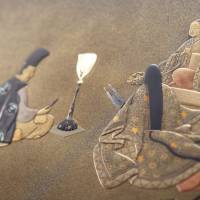In Kyoto, the decorative Japanese lacquer technique of maki-e is called Kyo-Maki-e. Invented during the Nara Period (710-794), maki-e became popular during the Heian Period (794-1192). It developed alongside the traditional tea ceremony, which flourished in Kyoto from the Muromachi Period (1336-1573).
Maki-e involves the use of gold or silver powder sprinkled over designs to embellish them. This exhibition presents various lacquerware works, including "The Tale of Genji E Dana," which has not been on public display for 30 years; till June 28.
Zohiko Urushi Museum; (075) 752-7790; Zohiko Main Shop 2F, 10 Saishoji-cho, Okazaki, Sakyo-ku, Kyoto; Higashiyama Station, Tozai Line. 10 a.m.- 5 p.m. ¥300. Closed Wed., May 20, 21. www.zohiko.co.jp/museum/en

















With your current subscription plan you can comment on stories. However, before writing your first comment, please create a display name in the Profile section of your subscriber account page.